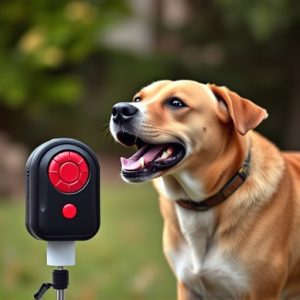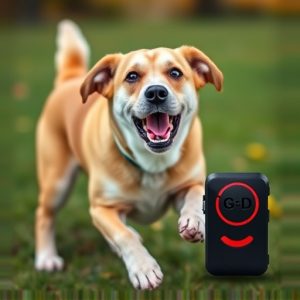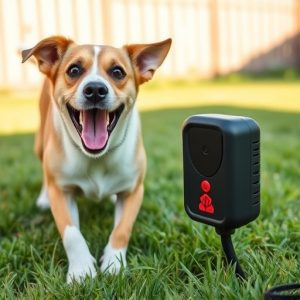Safe Pet Control: Sonic Technology and Dog Repellent Devices
Sonic technology offers humane dog repellent devices using high-frequency sound waves (20-50 kHz) to…….
Sonic technology offers humane dog repellent devices using high-frequency sound waves (20-50 kHz) to deter dogs. The best vibration settings are crucial, balancing effectiveness with comfort to avoid hearing damage or discomfort. Adjusting the settings based on your pet's breed and size ensures safe, tailored deterrence. Responsible use includes considering environmental impact and adhering to manufacturer guidelines for optimal results without disturbing neighbors or local wildlife.
Introducing a revolutionary approach to pet control, safe and effective: sonic technology. This innovative method leverages high-frequency sound waves to deter unwanted pets without harm. Our article delves into the science behind dog repellent devices, exploring how they work and emphasizing the importance of best vibration settings for optimal results. We also cover safety considerations and the environmental impact, ensuring responsible pet management while highlighting the dog repellent device‘s potential as a game-changer in pest control.
- Understanding Sonic Technology for Pet Control
- The Science Behind Dog Repellent Devices
- Choosing the Best Vibration Settings
- Safety Considerations and Environmental Impact
Understanding Sonic Technology for Pet Control
Sonic technology for pet control has emerged as a safe and effective method to keep unwanted animals at bay, especially when it comes to protecting your pets and home. This innovative approach leverages high-frequency sound waves, typically in the range of 20-50 kHz, which are imperceptible to humans but can be very disturbing to dogs and cats. By adjusting the vibration settings on these devices, you can target specific behaviors like barking or prowling without causing harm.
The best vibration settings for a dog repellent device often lie in finding a balance between comfort and effectiveness. While higher frequencies can be more disruptive, they might also lead to hearing damage if not used properly. Lower frequencies, closer to 20 kHz, are generally safer but may not produce the same level of distress. It’s crucial to select a device that allows for adjustable settings so you can customize the vibration intensity based on your pet’s sensitivity and the specific behavior you’re targeting. This ensures that your pet is deterred without being subjected to unpleasant or harmful experiences.
The Science Behind Dog Repellent Devices
Dog repellent devices use a technology based on sound waves and vibrations to deter canine intrusions. The science behind these innovative solutions lies in their ability to emit specific frequencies that target a dog’s sensitive hearing. When activated, these devices emit high-pitched sounds or gentle vibrations at optimal best vibration settings tailored to be unpleasant for dogs without causing harm. This technology takes advantage of a dog’s natural aversion to certain noises and vibrations, effectively guiding them away from treated areas.
The effectiveness of dog repellent devices depends on the right combination of frequency and intensity. Different breeds and sizes of dogs have varying thresholds for what constitutes an uncomfortable sound or vibration. Therefore, the best vibration settings for one device may differ for another. Manufacturers often conduct extensive research to establish these optimal parameters, ensuring both safety and efficiency in keeping pets at bay without resorting to potentially harmful chemicals or electric shocks.
Choosing the Best Vibration Settings
When it comes to choosing the best vibration settings for a dog repellent device using sonic technology, finding the right balance is key. Too high a frequency may startle your pet without effectively deterring them, while too low might not be noticeable enough. The ideal setting falls between 20-50 kHz, as this range is generally effective in gently disturbing dogs without causing harm or discomfort.
It’s important to note that different dog breeds and sizes can have varying sensitivity levels to sound. Smaller breeds often have more delicate hearing, so higher vibration settings might be too intense for them. Conversely, larger dogs may need stronger vibrations to respond effectively. Adjusting the device according to your pet’s specific needs ensures a safe and humane training experience.
Safety Considerations and Environmental Impact
When considering safe pet control sonic technology, such as dog repellent devices that use sound waves, it’s crucial to balance effectiveness with safety. These devices operate on the principle of emitting high-frequency sounds that are unpleasant to animals like dogs and cats, encouraging them to stay away from treated areas. However, not all devices are created equal; the best vibration settings should be adjusted to avoid potential harm to both pets and humans. Extreme or incorrect settings could lead to discomfort, stress, or even physical injury. It’s essential to follow manufacturer guidelines and test different frequencies to find the most effective yet safe setting for your environment.
Beyond individual safety, pet owners must also consider the environmental impact of these devices. While sonic repelents are generally seen as more humane alternatives to traditional chemical sprays, their effectiveness can vary based on factors like weather conditions, terrain, and the target animal’s tolerance to sound. Moreover, some devices might produce sounds within the range audible to humans, which could be disturbing to neighbors or disrupt local wildlife. Responsible use involves understanding these variables and choosing settings that minimize any potential adverse effects, ensuring a harmonious balance between pet control and ecological preservation.
Sonic technology offers a safe and effective solution for pet control, particularly with dog repellent devices. By understanding the science behind these devices and selecting the optimal vibration settings, pet owners can ensure their furry friends stay in check without causing harm. When choosing a device, consider safety features and environmental impact to find the best fit for your needs. Remember, the right vibration settings are key to effective and humane pet control.


